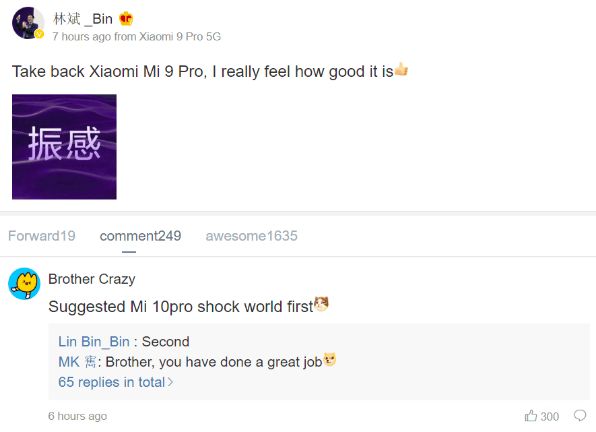Xiaomi had launched the Xiaomi Mi 9 back in February. The Mi 9 family includes members like Mi 9 SE, Mi 9 Explorer, Mi 9 Lite, Mi 9T, Mi 9T Pro and Mi 9 Pro 5G. Recent rumors have suggested that the company could be working on Xiaomi Mi 10 and it could be planning to debut the Mi 10 series by the first quarter of 2020. On Weibo, Xiaomi President Lei Bin replied to a Mi user’s comment by saying that Mi 10 Pro will be succeeding the Xiaomi Mi 9 Pro.
Bin’s reply is enough to confirm the existence of the Mi 10 Pro smartphone. Hence, it appears that the series will at least include two phones such as Mi 10 and Mi 10 Pro. The arrival of the Mi 10 lineup could be nearing as the company has recently delisted the Xiaomi Mi 9 phone from its product portfolio.
Editor’s Pick: Xiaomi Mi 10: What to expect?
At the end of November, two new 5G-ready devices with model numbers M2001J2E/C and M2001J1E/C were certified by the 3C authority of China. The MJ2001J2E/C phone’s 3C listing had revealed that it could be shipped with MDY-11-EF charger that supports up to 30W charging. It is the same charger that powers the Xiaomi Mi CC9 Pro’s massive 5,260mAh battery with up to 30W charging rates.
On the other side, the M2001J1E/C phone was seen with MDY-11-EB that supports up to 66W fast charging. This 5G phone from Xiaomi may debut as the fastest charging capabilities seen on a smartphone. It remains to be seen whether the MJ2001J2E/C and MJ2001J1E/C arrives in the market with respective names such as Xiaomi Mi 10 and Mi 10 Pro.
At present, there is no information available on the other specs of the Xiaomi Mi 10 Pro. Being a flagship phone, it could be powered by the Snapdragon 865 mobile platform that will made official soon. It is very likely to come preloaded with MIUI 11 based Android 10 OS. Probably, the camera system of the Mi 10 series could be equipped with a 108-megapixel primary lens.
In related news, Xiaomi India is reportedly gearing up to launch the Xiaomi Mi Note 10 phone in India. The world’s first smartphone with 108-megapixel penta-lens camera setup may launch by January 2020.
UP NEXT: Samsung leads in global TV sales while Xiaomi holds 5th spot as sales decline








